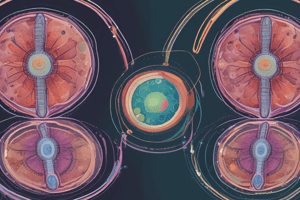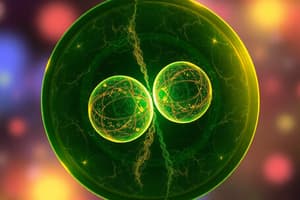Podcast
Questions and Answers
What is the definition of mitosis?
What is the definition of mitosis?
Cell division in which the nucleus divides into nuclei containing the same number of chromosomes. Two daughter cells identical to the parent. It takes 2 to 4 hours and is constant. Segregation of sister chromatids. Growth of the embryo and in somatic cells capable of cell division. The stages include prophase, metaphase, anaphase, telophase, and cytokinesis.
What is the definition of nondisjunction?
What is the definition of nondisjunction?
An error in meiosis or mitosis in which members of a pair of homologous chromosomes or a pair of sister chromatids fail to separate properly from each other.
What is the definition of the cell cycle?
What is the definition of the cell cycle?
The time from the birth of a new somatic cell until it divides into two new daughter cells. It includes interphase (the period between cell division) and mitosis (the period of actual cell division).
What is the definition of interphase?
What is the definition of interphase?
What is the spindle assembly checkpoint?
What is the spindle assembly checkpoint?
What is the G1 checkpoint?
What is the G1 checkpoint?
What is the resting state?
What is the resting state?
What are the interphase stages in order?
What are the interphase stages in order?
What is the G0 phase?
What is the G0 phase?
What happens after cytokinesis?
What happens after cytokinesis?
What is the role of p53 in the cell cycle?
What is the role of p53 in the cell cycle?
What happens when DNA damage results in an increased level of p53 protein?
What happens when DNA damage results in an increased level of p53 protein?
What happens with a loss of p53 tumor suppressor activity?
What happens with a loss of p53 tumor suppressor activity?
What is prophase?
What is prophase?
What are homologous chromosomes?
What are homologous chromosomes?
What are sister chromatids?
What are sister chromatids?
What happens during mitotic non-disjunction during embryogenesis?
What happens during mitotic non-disjunction during embryogenesis?
What can mitotic non-disjunction during embryogenesis lead to?
What can mitotic non-disjunction during embryogenesis lead to?
What is mosaicism?
What is mosaicism?
What is meiosis in males?
What is meiosis in males?
What is spermatogenesis?
What is spermatogenesis?
What is oogenesis?
What is oogenesis?
What is meiosis I?
What is meiosis I?
What does crossing over ensure?
What does crossing over ensure?
What are the crucial roles of meiosis?
What are the crucial roles of meiosis?
What happens during non-disjunction in meiosis I?
What happens during non-disjunction in meiosis I?
What are the effects of non-disjunction during meiosis?
What are the effects of non-disjunction during meiosis?
What is monosomy?
What is monosomy?
What is Turner syndrome?
What is Turner syndrome?
What is meant by a pair of homologous chromosomes?
What is meant by a pair of homologous chromosomes?
What is maternal uniparental disomy?
What is maternal uniparental disomy?
What is a paternally imprinted gene?
What is a paternally imprinted gene?
What are some genetic conditions associated with chromosome 15?
What are some genetic conditions associated with chromosome 15?
What does Me-Si stand for?
What does Me-Si stand for?
What is the effect of a sex chromosome nondisjunction in males during meiosis I on the zygote?
What is the effect of a sex chromosome nondisjunction in males during meiosis I on the zygote?
What is the effect of a nondisjunction of an X chromosome in the ovum?
What is the effect of a nondisjunction of an X chromosome in the ovum?
What does male meiosis produce?
What does male meiosis produce?
At what time do mitotic divisions of cells occur in males and females?
At what time do mitotic divisions of cells occur in males and females?
What is the timeline of gametogenesis in females?
What is the timeline of gametogenesis in females?
What is the timeline of male gametogenesis?
What is the timeline of male gametogenesis?
What are the defects if maternal or paternal age is increased?
What are the defects if maternal or paternal age is increased?
What is Klinefelter syndrome (XXY)?
What is Klinefelter syndrome (XXY)?
At the beginning of meiosis, how many chromosomes and sister chromatids are there?
At the beginning of meiosis, how many chromosomes and sister chromatids are there?
At the end of meiosis I, how many chromosomes and sister chromatids are there?
At the end of meiosis I, how many chromosomes and sister chromatids are there?
At the end of meiosis II, how many chromosomes and chromatids are there?
At the end of meiosis II, how many chromosomes and chromatids are there?
Flashcards
Mitosis
Mitosis
cell division in which the nucleus divides into nuclei containing the same number of chromosomes. Two daughter cells identical to the parent. 2 to 4 hours and is constant. Segregation of sister chromatids. Growth of embryo and in somatic cells capable of cell division. Prophase, metaphase, anaphase, telophase, and cytokinesis.
Meiosis
Meiosis
a type of cell division that results in four daughter cells each with half the number of chromosomes of the parent cell, as in the production of gametes and plant spores.
Nondisjunction
Nondisjunction
An error in meiosis or mitosis in which members of a pair of homologous chromosomes or a pair of sister chromatids fail to separate properly from each other.
Cell cycle
Cell cycle
Signup and view all the flashcards
Interphase
Interphase
Signup and view all the flashcards
Spindle assembly checkpoint
Spindle assembly checkpoint
Signup and view all the flashcards
G1 checkpoint
G1 checkpoint
Signup and view all the flashcards
Resting state (G0)
Resting state (G0)
Signup and view all the flashcards
G2 checkpoint
G2 checkpoint
Signup and view all the flashcards
Interphase stages in order
Interphase stages in order
Signup and view all the flashcards
G1 stage
G1 stage
Signup and view all the flashcards
S phase
S phase
Signup and view all the flashcards
G2 phase
G2 phase
Signup and view all the flashcards
M phase
M phase
Signup and view all the flashcards
After cytokinesis...
After cytokinesis...
Signup and view all the flashcards
Role of p53 in cell cycle
Role of p53 in cell cycle
Signup and view all the flashcards
DNA damage results in increased level of p53 protein which causes:
DNA damage results in increased level of p53 protein which causes:
Signup and view all the flashcards
Loss of p53 tumor suppressor activity
Loss of p53 tumor suppressor activity
Signup and view all the flashcards
Prophase
Prophase
Signup and view all the flashcards
Homologous chromosomes
Homologous chromosomes
Signup and view all the flashcards
Sister chromatids
Sister chromatids
Signup and view all the flashcards
Metaphase
Metaphase
Signup and view all the flashcards
Anaphase
Anaphase
Signup and view all the flashcards
Telophase
Telophase
Signup and view all the flashcards
Mitotic non disjunction durring embryogenesis
Mitotic non disjunction durring embryogenesis
Signup and view all the flashcards
Mitotic non disjunction during embryogenesis can lead to:
Mitotic non disjunction during embryogenesis can lead to:
Signup and view all the flashcards
Trisomy 21
Trisomy 21
Signup and view all the flashcards
Mosaicism
Mosaicism
Signup and view all the flashcards
Meiosis in males
Meiosis in males
Signup and view all the flashcards
Meiosis in females
Meiosis in females
Signup and view all the flashcards
Spermatogenesis
Spermatogenesis
Signup and view all the flashcards
Oogenesis
Oogenesis
Signup and view all the flashcards
Study Notes
Mitosis
- Cell division resulting in two identical daughter cells.
- Occurs in somatic cells for growth and repair.
- Takes 2 to 4 hours.
- Stages: prophase, metaphase, anaphase, telophase, and cytokinesis.
- Sister chromatids separate during anaphase.
Meiosis
- Cell division producing four genetically unique haploid daughter cells (gametes).
- Crucial for sexual reproduction.
- Occurs only in gamete-forming cells.
- Gametes have half the chromosome number of the parent cell.
- Important for genetic variation.
Nondisjunction
- Error during meiosis or mitosis where homologous chromosomes or sister chromatids fail to separate properly.
- Can occur in meiosis I or II.
- Leads to aneuploidy (abnormal chromosome number) in daughter cells.
- Increased risk with maternal age.
Cell Cycle
- Series of events from one cell division to the next.
- Consists of interphase (G1, S, G2) and mitosis (M).
Interphase
- Period between cell divisions.
- Includes G1, S, and G2 phases.
- Crucial for cell growth and DNA replication.
Spindle Assembly Checkpoint
- Mechanism ensuring all chromosomes are properly attached to the spindle fibers before anaphase.
Cell Cycle Checkpoints
- G1 checkpoint: checks for cell size, nutrients, growth factors, and DNA damage.
- G2 checkpoint: checks for cell size and DNA replication.
G0 Phase
- Resting state where cells are not actively dividing.
- Allows for repair or other specialized functions.
G1 Stage
- Cell grows in size, and makes necessary proteins.
- Determines if conditions are favorable for division.
S Phase
- DNA replication occurs.
- Each chromosome now consists of two sister chromatids.
G2 Phase
- Cell prepares for mitosis.
- Checks for DNA replication completion.
M Phase
- Includes mitosis and cytokinesis.
- Cell division stage.
Cytokinesis
- Division of the cytoplasm to form two daughter cells.
- Results in two daughter cells with identical genetic makeup.
P53 Gene and Cell Cycle Regulation
- Tumor suppressor gene that plays a role in cell cycle regulation.
- Monitors DNA damage.
- Can induce cell cycle arrest, DNA repair, or apoptosis (programmed cell death) if damage is extensive.
- Decreased activity can lead to uncontrolled cell growth and tumor development.
Mitosis Phases
- Prophase: Nucleus dissolves, chromosomes condense, mitotic spindle from.
- Metaphase: Chromosomes align at the metaphase plate.
- Anaphase: Sister chromatids separate and move to opposite poles.
- Telophase: Nuclear envelopes re-form, chromosomes decondense.
Mitosis Non-disjunction
- Error in mitosis resulting in cells with abnormal chromosome numbers.
- Primarily of diagnostic concern during embryogenesis.
- Causes mosaicism.
Trisomy 21
- Condition where an individual has three copies of chromosome 21.
- Leads to Down syndrome.
Mosaicsm
- Presence of different karyotypes (chromosome arrangements) within the same individual.
Male Meiosis
- Produces four haploid sperm cells.
Female Meiosis
- Produces one ovum (egg) and three polar bodies.
Meiosis I
- Homologous chromosome pairs separate.
Meiosis II
- Sister chromatids separate.
Crossing Over
- Exchange of genetic material between homologous chromosomes during meiosis I; leads to genetic variation.
Meiosis Non-disjunction
- Failure of homologous chromosomes or sister chromatids to separate during meiosis.
- Increases risk of aneuploidy.
- Consequences are more consequential in gametes than in somatic cells.
Monosomy
- Presence of only one copy of a particular chromosome.
Turner Syndrome
- Chromosomal disorder (XO) in females; missing or abnormal X chromosome.
Uniparental Disomy
- Inheritance of both copies of a chromosome from one parent.
Imprinted Genes
- Genes whose expression depends on the parent of origin.
Chromosome 15
- Associated with genetic disorders like Prader-Willi and Angelman syndromes.
Meiosis-I and Meiosis-II Non-disjunction Consequences
- Risks increase with increasing parental age, especially maternal age.
Klinefelter Syndrome (XXY)
- Chromosomal disorder in males (XXY); extra X chromosome.
Gametogenesis Timelines
- Males: Begins at puberty, continues throughout life.
- Females: Completed gametes (primary oocytes) produced before birth, and meiosis II only completed during fertilization.
Studying That Suits You
Use AI to generate personalized quizzes and flashcards to suit your learning preferences.




